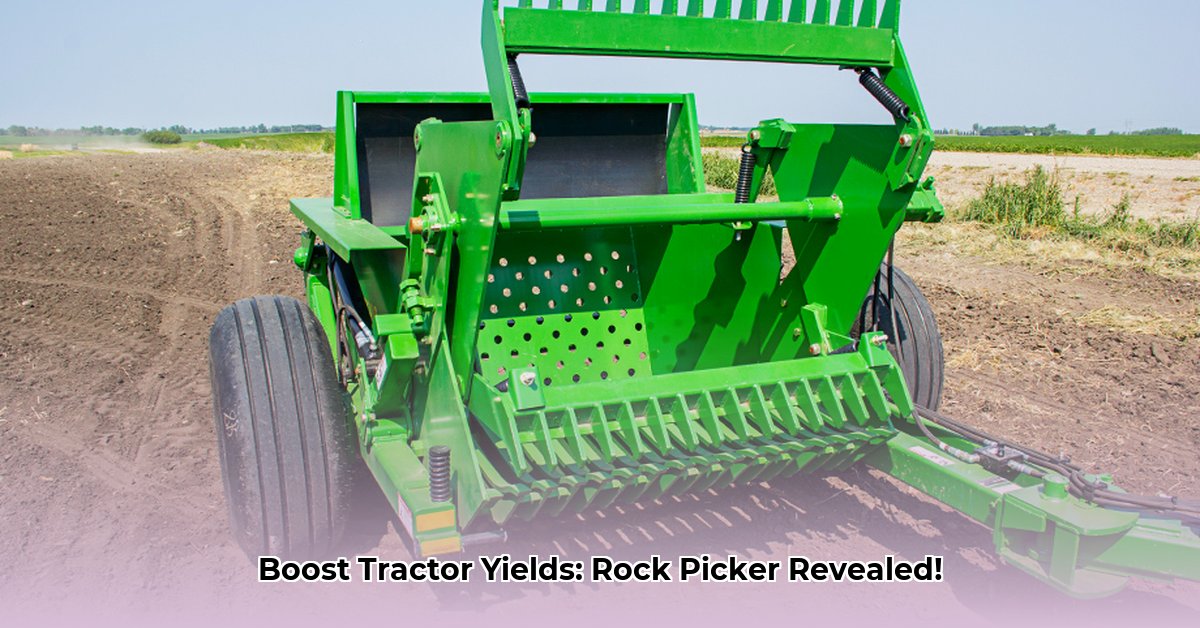
Choosing the right rock picker can significantly impact your farm's efficiency and profitability. Rocks hidden beneath the soil surface damage equipment, reduce crop yields, and increase operational costs. This comparative review and instructional guide will help you select the optimal rock picker for your specific needs, maximizing your return on investment (ROI) while promoting sustainable agricultural practices. For additional information on tractor implements, check out this helpful resource on tractor attachments.
Understanding Your Rock Removal Needs
Before selecting a rock picker, a thorough assessment of your farm's characteristics is crucial. This involves evaluating factors like field size, soil type, rock density and size, and your overall budget. Ignoring these initial steps can lead to an inefficient and ultimately costly choice. What are your farm's unique challenges related to rock removal? How will those challenges influence your selection criteria?
Types of Rock Pickers: A Detailed Comparison
Three primary types of rock pickers exist, each with distinct advantages and disadvantages:
Rotary Rock Pickers: These high-capacity machines utilize spinning rotors to fling stones clear of the field. They are ideal for large areas with a high rock density. However, they typically exhibit higher fuel consumption and maintenance requirements.
Oscillating Drum Bed Rock Pickers: These gentler options use a rocking motion to move rocks onto a conveyor belt, minimizing soil compaction. While they handle a moderate capacity, their operational speed is slower than rotary models.
Dragging Method Rock Pickers: These simple, cost-effective tools employ tines or chains to drag rocks to the surface. Best-suited for smaller fields or lighter rock infestations, but their capacity and efficiency limit their suitability for large-scale operations.
Key Factors for Rock Picker Selection: A Comparative Analysis
The following table compares the three types based on crucial factors influencing your decision, directly impacting your long-term ROI:
| Feature | Rotary | Oscillating Drum Bed | Dragging Method |
|---|---|---|---|
| Capacity | High; Handles larger stones | Moderate capacity; handles varied sizes | Low capacity; smaller stones only |
| Efficiency | High speed; high fuel consumption | Moderate speed; lower fuel consumption | Low speed; lowest fuel consumption |
| Durability | Variable; higher maintenance needs | Typically durable; moderate maintenance | Simple design; low maintenance requirements |
| Cost | High initial investment; high running costs | Moderate initial investment; moderate running costs | Low initial investment; low running costs |
| Environmental Impact | Higher fuel consumption; potential for soil compaction | Lower fuel consumption; minimal soil compaction | Very low fuel consumption; minimal soil compaction |
Making the Right Choice: A Step-by-Step Guide
Choosing the right rock picker is a multi-step process that demands careful consideration of your farm’s unique conditions and long-term goals. Following these detailed steps will help ensure you make the informed decision that best suits your specific needs:
Assess Your Farm: Carefully evaluate the size of your fields, soil type (clay soils are more susceptible to compaction), the prevalence and size of rocks, and your budget constraints.
Define Your Requirements: Based on your assessment, determine the necessary capacity, desired efficiency, acceptable maintenance level, and environmental impact limits.
Compare Models: Use the table above to systematically compare different models based on your prioritized criteria. Secure detailed specifications from manufacturers and gather independent reviews if available.
Calculate Total Cost of Ownership: Factor in the initial investment, ongoing operational costs (fuel consumption), maintenance expenses, and repairs. This approach prevents short-sighted decisions based solely on the initial purchase price.
Evaluate Long-Term ROI: Project your potential yield increase resulting from effective rock removal. A more efficient rock picker might significantly improve the economic viability of your operation, offsetting higher initial investment costs.
Seek External Advice: Consult with experienced farmers, agricultural machinery specialists, or your local agricultural extension agent for valuable insights and personalized guidance.
Beyond the Machine: Sustainable Farming Practices
Investing in a rock picker is crucial for sustainable farming. However, it's only one element of a comprehensive approach. Consider integrating strategies like crop rotation, reduced tillage, and mindful soil management to enhance soil health and long-term productivity. The integration of these practices will lead to environmental benefits and enhanced economic sustainability.
Conclusion: Optimizing Your Harvest
The optimal rock picker depends entirely on your specific needs and circumstances. A thorough evaluation of your farm's characteristics, a careful comparison of different models, and a long-term perspective on the return on investment will lead to the most productive and sustainable solution. Remember, continual advancements in agricultural technology are occurring; staying informed about the latest developments keeps your farm at the cutting edge of efficiency and sustainability.